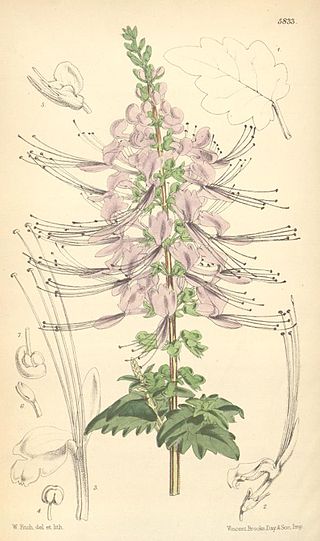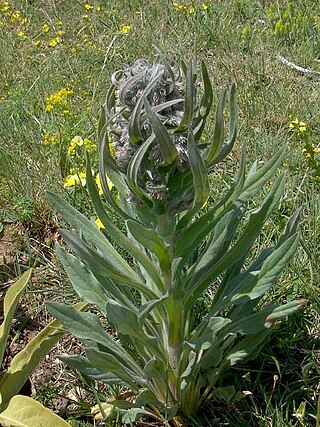
The Lamiaceae or Labiatae are a family of flowering plants commonly known as the mint, deadnettle, or sage family. Many of the plants are aromatic in all parts and include widely used culinary herbs like basil, mint, rosemary, sage, savory, marjoram, oregano, hyssop, thyme, lavender, and perilla, as well as other medicinal herbs such as catnip, salvia, bee balm, wild dagga, and oriental motherwort. Some species are shrubs, trees, or, rarely, vines. Many members of the family are widely cultivated, not only for their aromatic qualities, but also their ease of cultivation, since they are readily propagated by stem cuttings. Besides those grown for their edible leaves, some are grown for decorative foliage. Others are grown for seed, such as Salvia hispanica (chia), or for their edible tubers, such as Plectranthus edulis, Plectranthus esculentus, Plectranthus rotundifolius, and Stachys affinis. Many are also grown ornamentally, notably coleus, Plectranthus, and many Salvia species and hybrids.

Ocimum is a genus of aromatic annual and perennial herbs and shrubs in the family Lamiaceae, native to the tropical and warm temperate regions of all 6 inhabited continents, with the greatest number of species in Africa. It is the genus of basil and its best known species are the cooking herb great basil, O. basilicum, and the medicinal herb tulsi, O. tenuiflorum.

Umbilicus is a genus of over ninety species of flowering plants in the family Crassulaceae. Many of its species have been given synonyms under different genera such as Rosularia, Cotyledon, and Chiastophyllum. However, those that remain in Umbilicus are listed below:

Orange oil is an essential oil produced by cells within the rind of an orange fruit. In contrast to most essential oils, it is extracted as a by-product of orange juice production by centrifugation, producing a cold-pressed oil. It is composed of mostly d-limonene, and is often used in place of pure d-limonene. D-limonene can be extracted from the oil by distillation.

Orthosiphon is a genus of plants in the family Lamiaceae native to Africa, Southern Asia and Queensland, with one species (O. americanus) in Colombia. They are herbaceous shrubs which grow to a height of 1.5 m (5 ft). Some Orthosiphon species are popular garden plants because of their flowers, which are white and bluish with filaments resembling a cat's whiskers. In the wild, the plants can be seen growing in forests and along roadsides.

Orthosiphon aristatus, commonly known as cat's whiskers or Java tea, is a plant species in the family Lamiaceae. The plant is a medicinal herb found mainly throughout southern China, the Indian Subcontinent, South East Asia, and tropical Queensland, Australia. As a medical herb, it is used for increasing excretion of urine, lowering uric acid, protecting kidney, reducing oxidative stress, reducing inflammation, protecting liver, protecting stomach, lowering blood pressure, ameliorating diabetes, ameliorating hyperlipidemia, fighting microorganisms and fighting anorexia. It is known as kumis kucing in Indonesia and misai kucing in Malaysia, both of which translate to cat's whiskers.
Orthosiphon ferrugineus, the Socotran piccadill, is a species of flowering plant in the family Lamiaceae. It is found only on Socotra Island, part of the nation of Yemen. Its natural habitat is subtropical or tropical dry shrubland. It belongs under the class of Magnoliopsida.
Awaous is a genus of fish in the family Gobiidae, the gobies. They are native to fresh, marine and brackish waters from Africa to the Americas.
Awaous stamineus, commonly known as ‘O‘opu nakea, is a species of goby native to the Hawaiian Islands. It has been previously considered a synonym of Awaous guamensis but recent work based upon morphological and genetic differences has recognized Hawaiian populations as being distinct. Consequently, Hawaiian Awaous are now recognized as a valid, distinct species.

Sicyopterus stimpsoni, commonly known as the Nopoli rockclimbing goby, oopu nopili, or Stimpson's goby, is a species of amphidromous goby endemic to the U.S. state of Hawaii. This species can reach a length of 19.8 centimetres (7.8 in) SL.

Solenanthus is a genus of flowering plants in the family Boraginaceae.

Bromus carinatus is a species of brome grass known by the common names California brome and mountain brome.
For whiskers found on cats and other animals, see Whiskers. Cat's whiskers may also refer to:
Awaous guamensis is a species of goby native to the Pacific islands from the Marianas to Vanuatu, New Caledonia and Fiji where it can be found in fresh, brackish and marine waters. Recent work based upon morphological and genetic differences has recognized Hawaiian populations of Awaous as being distinct from Awaous guamensis. Consequently, Hawaiian Awaous are now recognized as a distinct species Awaous stamineus.

Lunella torquata, common name the twisted necklace, is a species of sea snail, a marine gastropod mollusk in the family Turbinidae, the turban snails.

Catoferia is a small genus of plants in the family Lamiaceae composed of only four species. The majority of the species in this genus are confined to southern Mexico, with one species being recorded from Central America, Colombia and Peru in addition to southern Mexico. The beginning of this genus has been traced back to the Cretaceous era, making the genus around 55 to 65 million years old.

Agrivoltaics is the dual use of land for solar energy production and agriculture. The technique was conceived by Adolf Goetzberger and Armin Zastrow in 1981. Agrivoltaics includes multiple methods of combining agriculture with photovoltaics, according to the agricultural activity, including plants, livestock, greenhouses, and pollinator support.

Nepetoideae is a subfamily of plants in the family Lamiaceae.















